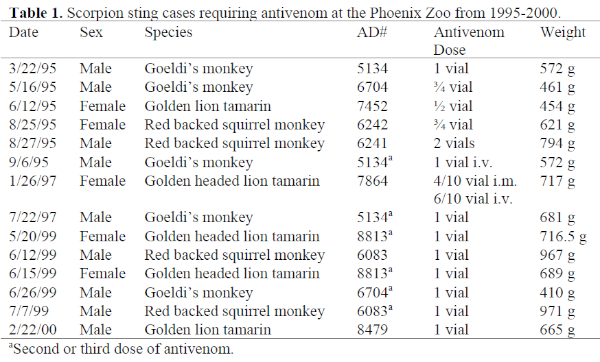Abstract
The Phoenix Zoo is located in a large natural desert city park within the natural range of the bark scorpion Centruroides sculpturatus. Because we built our zoo within this range, we have unavoidable encounters between our zoo animals and bark scorpions.
Bark scorpions are small scorpions (13–75 mm) but produce a potent neurotoxic venom that can be life threatening, especially in small animals. Centruroides sculpturatus is the only scorpion species in the continental United States that is dangerous to humans. The toxin is produced in paired venom glands located in the last tail segment which is called a telson. The telson also has a stinger to inoculate the venom into prey or enemies.
Bark scorpion venom is a complex mixture of mostly basic proteins of low molecular weight. These proteins are neurotoxins that act by affecting the sodium channel function of neurons in a way that causes or enhances repetitive firing. The venom contains no enzymes that cause tissue destruction, so there is usually no inflammation at the site of the sting.
Most clinical signs in humans and small primates are the result of repetitive firing of neurons in various organs. Humans report a painful tingling or burning sensation at the site of the sting. Hyperesthesia, paresthesia, muscle twitching or fasciculation, excessive salivation, trouble swallowing, roving or rotary eye movements, vomiting, and loss of control of pharyngeal muscles with resulting asphyxiation are the signs common in non-human primates and humans. Other symptoms that have been reported by humans, which cannot be observed in animals, include blurred vision, slurred speech, numbness and pain at the site of sting.
In the 6 years from 1995 to 2000, there were 14 cases of scorpion sting in squirrel monkeys and tamarins at The Phoenix Zoo, which were serious enough to require treatment with goat serum antivenom (Table 1). These small primates are insectivorous and are usually stung when catching the scorpions to eat them. We rarely identify the site of the sting and rarely find the scorpion, but the symptoms have become so familiar as to be pathognomonic.

The goat serum antivenom has been produced since 1965 and has, until recently, been produced by the Antivenom Production Laboratory at ASU in Tempe, AZ under the direction of Dr. William Northey. The antivenom was never available commercially, but it was supplied at no cost as an investigational drug to human hospitals and some veterinarians in Arizona and adjacent areas within the range of bark scorpions. We have seen no allergic reactions in our animals in spite of administering antivenom twice to four animals and three times to one animal. Production has stopped since retirement of technician Marilynn Bloom, who produced the last batch of antivenom in April 2001.
One vial of antivenom is usually given intravenously to any animal exhibiting life-threatening symptoms. Relief of symptoms occurs rapidly with return to normal function in 1–2 hours. Often the animals appear exhausted and have to be hospitalized for 1–2 days for supportive care. Animals stung before antivenom was available took 4–5 days to recover with intensive supportive therapy, and some died. Animals that are ataxic or salivating, but can still stand and move about, are not given antivenom and generally recover in 1–2 days.
The most common laboratory findings are hypoglycemia and extremely high CPK from muscular hyperactivity. Animals may be hypothermic or hyperthermic, depending on the weather and how soon after a sting they are found.
Scorpions are nocturnal and are not easily killed or controlled with “normal” pesticide treatments. They usually hide in dark, moist areas during the day. They are fairly long lived, unlike many arthropods; so removal of each individual adult significantly reduces the population. The three main methods of control used at the zoo are chickens and quail in high-risk exhibits to eat the scorpions, elimination of scorpion hiding places where possible, and nocturnal scorpion hunts by keepers using black lights (the scorpions fluoresce) and long forceps. The night’s catch used to be sent to the Antivenom Production Lab for antivenom production.
Climatic conditions seem to influence scorpion populations. There are more some years than others. In 1995 (a bad year), 32 bark scorpions were removed from an area of the zoo 1 week before a Goeldi’s monkey, who lived in that area, was stung. Six of our 14 cases occurred in 1995. Five cases occurred in 1999. There were only two cases in 1997, one in 2000, and none in 1996, 1998, and 2001. Bark scorpions are active seasonally, with most stings occurring in warm weather. Only two of our serious stings occurred during winter months.
Neurotoxicity from bark scorpion envenomation in our small primates has been a nontraditional but challenging problem to control and to treat. Fortunately, we have had a life-saving source of antivenom available to us from Arizona State University. We hope someone else will take on the task of producing bark scorpion antivenom again for the future before our stockpile is used up.